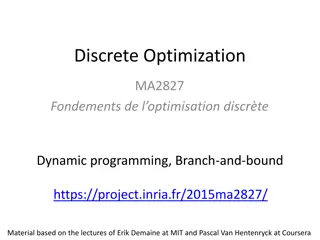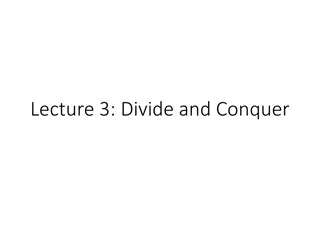Dynamic Programming in Discrete Optimization: A Powerful Algorithm Design Technique
Dynamic programming is a powerful algorithm design technique that allows solving complex problems efficiently by breaking them down into overlapping subproblems. This approach, as discussed in the material based on the lectures of Erik Demaine at MIT and Pascal Van Hentenryck at Coursera, involves r
0 views • 69 slides
Understanding Dynamic Programming in Algorithms
Dynamic programming and linear programming are powerful techniques that come into play when specialized methods fall short. Dynamic programming involves solving a problem by breaking it down into smaller subproblems and solving them incrementally. In this approach, the nodes represent subproblems, a
0 views • 40 slides
Introduction to Dynamic Programming: A Powerful Problem-Solving Technique
Dynamic programming (DP) is a bottom-up approach introduced by Richard Bellman in the 1950s. Similar to divide-and-conquer, DP breaks down complex problems into smaller subproblems, solving them methodically and storing solutions in a table for efficient computation. DP is widely used in optimizatio
0 views • 39 slides
Understanding Recursion in Programming
Recursion in programming involves a method calling itself to solve problems by breaking them down into simpler subproblems. The process requires a base condition, recursive calls, and progress towards termination. This technique is illustrated through examples like calculating factorials using recur
0 views • 64 slides
Understanding the Divide and Conquer Technique in Computer Science
The Divide and Conquer approach is a powerful strategy used in computer science to break down large problems into smaller, more manageable subproblems. By recursively solving these subproblems and combining their results, this technique offers a structured way to tackle complex tasks efficiently. Th
1 views • 59 slides
Efficient Algorithms: Divide and Conquer Techniques
Using the Divide and Conquer approach, this lecture discusses strategies for efficiently solving problems such as counting inversions in arrays and integer multiplication. By dividing tasks into smaller subproblems, sorting, merging, and efficiently counting operations, the algorithms presented opti
1 views • 13 slides
Divide and Conquer Algorithms - Dr. Maram Bani Younes
This chapter on divide and conquer algorithms introduces key concepts such as dividing the problem into smaller subproblems, solving them, and combining the solutions. It covers techniques like finding maximum and minimum elements, maximum contiguous subsequence sum, binary search, quick sort, merge
1 views • 30 slides
Dynamic Programming for Guitar Fingering Optimization
Explore dynamic programming concepts applied to guitar fingering optimization, minimizing the overall difficulty of playing a melody. Learn how to define subproblems, make guesses, and use recursion to find the best finger for each note, ultimately solving the original problem efficiently.
0 views • 18 slides
Dynamic Programming for Longest Palindromic Subsequence Algorithm
This content covers the topic of dynamic programming for finding the longest palindromic subsequence in a given string. It provides information on how to approach the problem, define the recurrence relation, establish base cases, and determine the order of solving subproblems. The discussion include
0 views • 19 slides
Understanding Recursion: A Fundamental Concept in Computer Science
Recursion is a fundamental concept in computer science that involves solving problems by breaking them down into smaller, similar subproblems. This content delves into the basics of recursion, highlighting key components such as the recursive case and base case. It also explores the concept of facto
0 views • 35 slides









